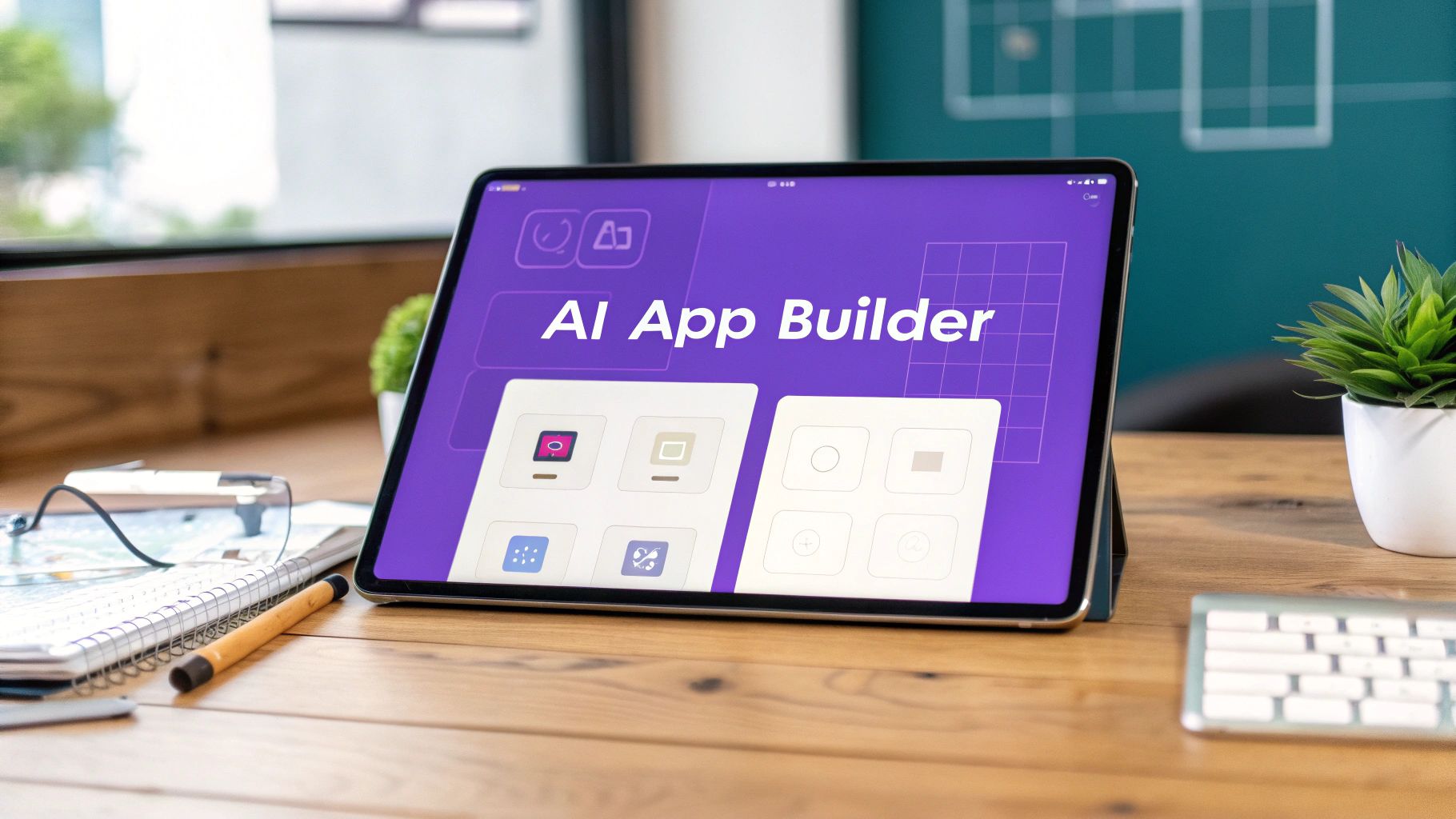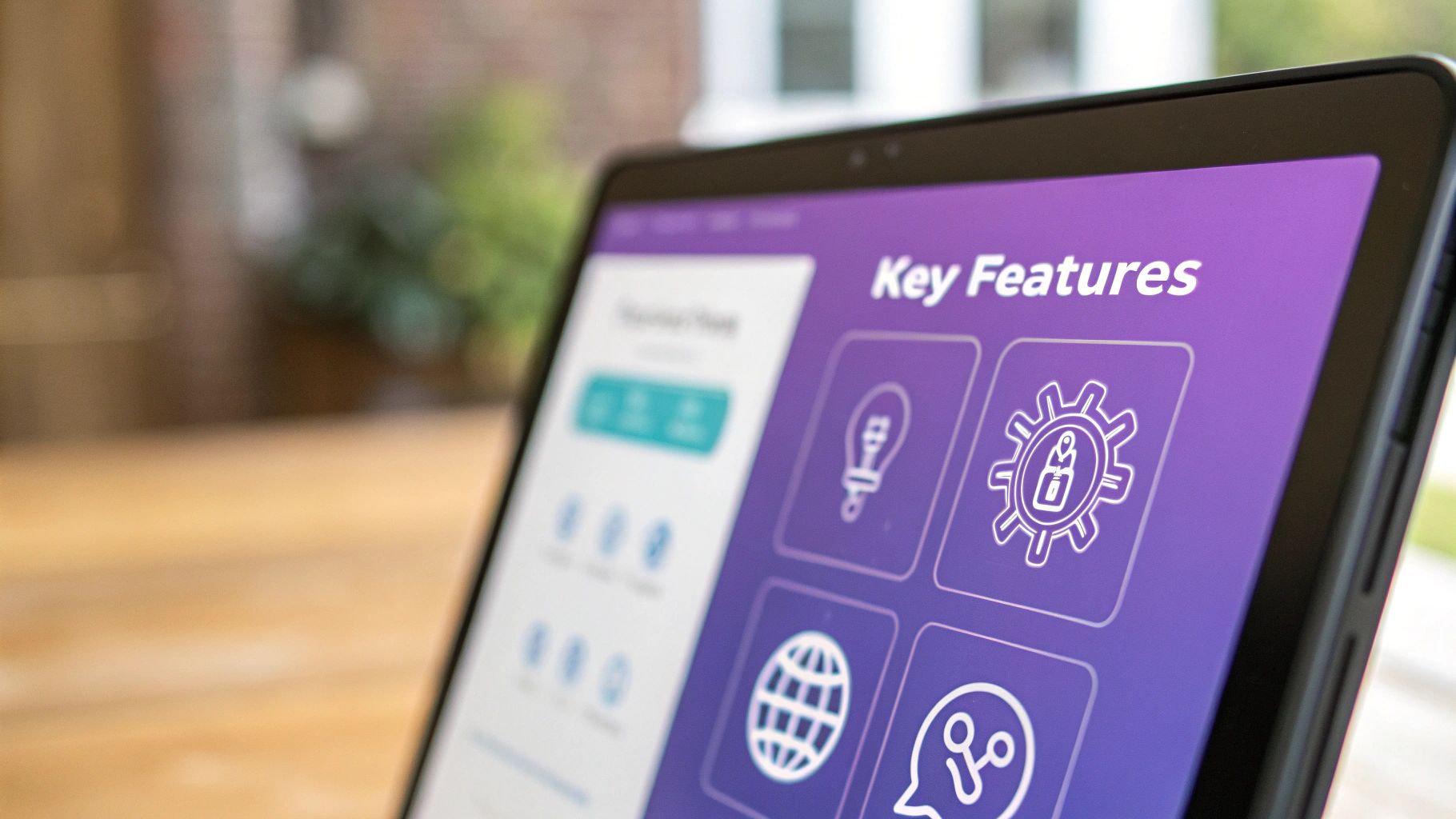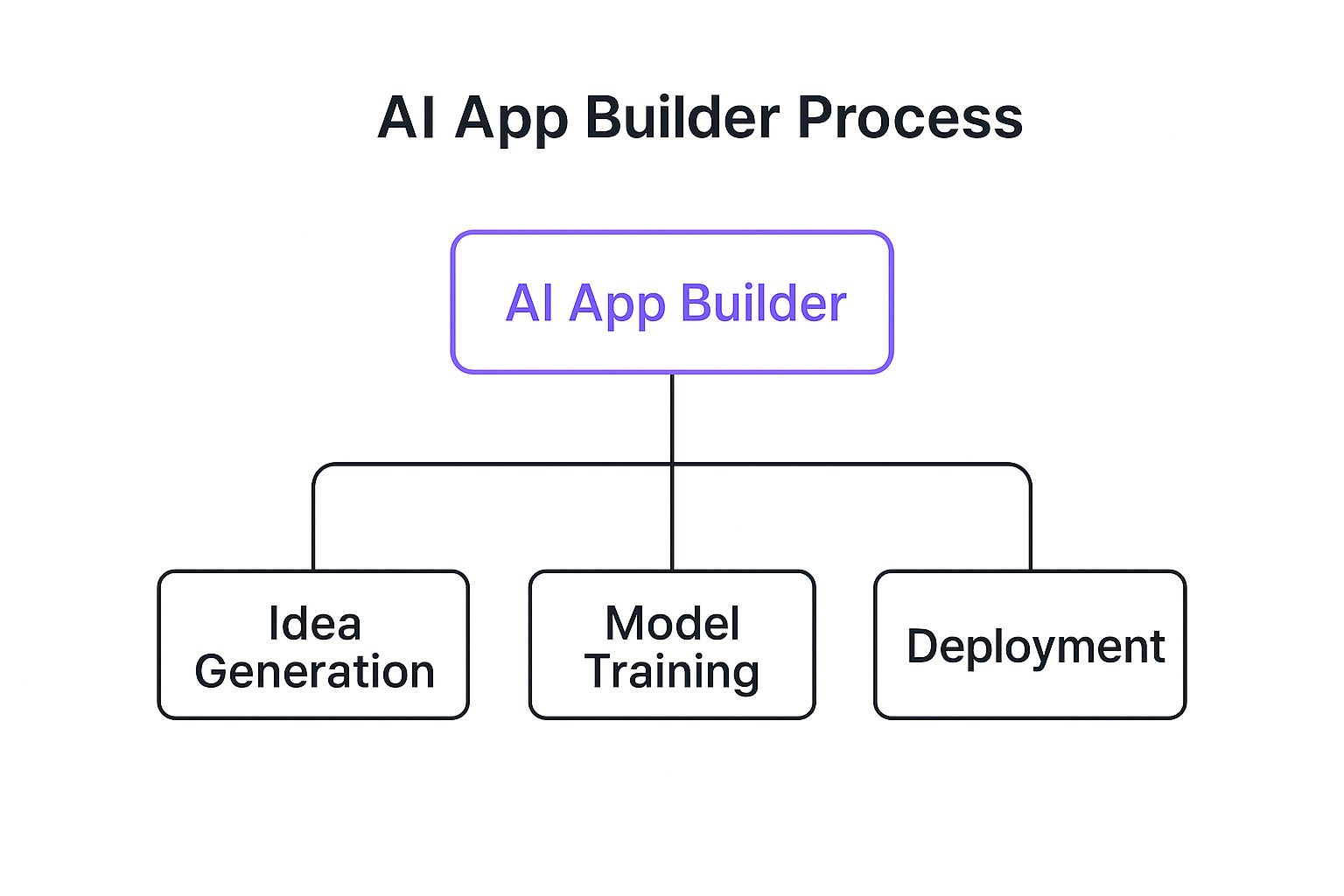Build Apps with an AI App Builder

Picture this: you have an entire team of top-tier software engineers at your beck and call, ready to turn your app idea into a fully functioning product. The catch? You don't write a single line of code. That's the core promise of a modern AI app builder. These platforms aren't just about cookie-cutter templates; they use genuine intelligence to understand what you want to build and then construct it from scratch.
The New Era of No-Code Creation
For a long time, building software was a walled garden. You needed deep technical skills, months (or years) of development time, and a serious budget. This kept a lot of incredible ideas from ever seeing the light of day. But that wall is starting to crumble.
The rise of the AI app builder is completely changing the game, handing the keys to a new wave of creators. Entrepreneurs, designers, and business owners can now build their own digital products without needing to become coding wizards. We're not just talking about dragging and dropping a few buttons here. This is about describing what you want your app to do in plain English and having an intelligent system figure out the complex logic and architecture for you.
Fueling a Market Explosion
This isn't some niche trend; it's a full-blown market explosion. In 2024 alone, the AI app sector brought in $4.5 billion. By 2030, that number is expected to blast past $150 billion. The user numbers tell the same story—an estimated 700 million people worldwide will be using AI apps by the middle of 2025. This surge makes one thing crystal clear: people want smarter, more intuitive ways to build and use software. You can dig deeper into these AI application market trends to see just how massive this shift is.
This chart really drives the point home, showing the wild revenue projections for the AI app market.

That steep curve isn't just hype. It's built on real consumer demand and serious investor belief in the power of AI-driven platforms.
From Simple Prompts to Powerful Apps
At its core, this whole movement is about closing the gap between a great idea and a finished product. These new platforms turn simple text prompts into surprisingly sophisticated apps.
Think of an AI app builder as your creative co-pilot. It translates your vision and handles all the messy technical stuff in the background. You get to focus on the what and why of your app, while the AI takes care of the how.
This changes everything. Instead of getting lost in code syntax and development frameworks, you can pour your energy into what really matters: nailing the user experience and creating real value. Tools like Dreamspace, an intuitive ai app generator, are leading this charge. They're making software development accessible to anyone, ready to unlock a new wave of innovation built by people who were previously locked out.
How AI App Builders Translate Ideas Into Code

So, how does an AI app builder actually turn a fleeting thought into a real, working piece of software? It’s not magic, but it’s close. Think of the platform less like a tool and more like your own dedicated creative agency.
You don't just walk into an agency and start rambling about server configurations or database schemas. You give them a brief. You explain your vision, who it’s for, and the problem you're trying to solve. An AI app builder works off the exact same principle, taking your creative direction and handling the technical heavy lifting for you.
Step 1: Tell It What You Want, In Your Own Words
It all starts with your vision. You use plain English to describe the core purpose of your app. You’re not writing code; you’re writing a mission statement.
For instance, you’d just state your goal. Simple.
- "Build an app for a local bookstore that lets people browse inventory and get personalized reading recommendations."
- "Create a tool for project managers to track team tasks and get daily progress summaries."
- "I need a simple chatbot to answer FAQs about our shipping policies."
The AI takes these instructions and breaks them down. It pulls out keywords like "browse inventory," "track tasks," and "answer FAQs" to map out the essential features your app needs. This first prompt is everything—it’s the blueprint.
Step 2: Picking the Right Brain for the Job
Once the platform knows what you want to build, it figures out how to build it intelligently. This is where it gets interesting. Modern AI app builders have a whole library of pre-trained AI models, each one a specialist in its own right. Think of it as your agency bringing in the experts.
Depending on your project, you might need:
- A Language Specialist (NLP Model): For that customer service chatbot, the builder grabs a Natural Language Processing model to understand and respond to human language.
- An Image Specialist (Computer Vision Model): Building an app to identify plants from a photo? It’ll pull in a computer vision model.
- A Data Analyst (Predictive Model): For the bookstore app, it selects a recommendation engine to analyze what users like and suggest other books they'll love.
This step is mostly automated. The platform matches your goals to the right AI model, so your app gets the specific intelligence it needs without you ever having to touch the complex machinery behind it.
Step 3: Designing the Vibe
With the logic sorted, the focus shifts to what the user actually sees and touches. This is where the drag-and-drop interface you know comes in, but with an AI co-pilot. Based on your prompt, the builder might suggest a layout, so you’re not just staring at a blank screen.
This is where your idea really starts to breathe. It's the digital version of looking at storyboards from your agency—you get to move things around and refine the look until it perfectly matches your vision.
You can shift components, tweak colors, and wire up screens to build the entire user journey. All the while, the AI app builder is in the background, writing the necessary front-end and back-end code to make it all work. This is exactly where platforms like the Dreamspace vibe coding studio shine. They provide an intuitive canvas that translates your creative direction directly into a functional, beautiful interface, killing the final barrier between a great idea and a real-world app.
What to Look For in an AI App Builder
Let's be real: not all AI app builders are the same. The market is flooded with tools, and it's getting harder to tell a powerful platform from a simple toy. If you're serious about building, you need to know what features actually matter.
Think of this as your guide to cutting through the noise. We'll break down the must-haves and the next-level features that separate the genuinely useful tools from the rest. Getting this right is the difference between a quick prototype and an app that's ready for the real world.
The Core Essentials
Any AI app builder worth your time has to nail the basics. These are the non-negotiables, the foundational features that make the whole process work.
- Natural Language Prompting: This is the starting point. You should be able to describe what you want your app to do in plain English, and the AI needs to get it. No weird syntax, just your idea translated into code and structure.
- Visual Workflow & UI Editors: AI gets you started, but you need to be in the driver's seat. A clean drag-and-drop interface is essential for tweaking the user interface (UI) and fine-tuning the app's logic until it's perfect.
- Seamless Data Integration: An app without data is just a pretty picture. The best builders let you securely plug into everything from Google Sheets and databases to third-party APIs with minimal fuss.
- Pre-Trained AI Model Library: You shouldn't have to build every AI model from scratch. A solid platform comes with a library of ready-to-go models for common tasks like text analysis, image recognition, or data forecasting.
With these features, you have a solid foundation to turn an idea into a working app. But for more ambitious projects, especially in the onchain world, you'll need more firepower.

Beyond the Basics: Advanced Capabilities
Once you move past the fundamentals, the top-tier platforms offer features designed to automate the entire lifecycle of your app. These are the signs of a truly mature and powerful builder.
A great AI app builder doesn't just help you build; it helps you launch, monitor, and scale. It's a partner for the entire journey, not just the starting line.
Features like one-click deployment are a game-changer, handling all the complex server setup and configuration for you. Another critical capability is automated performance analytics, which gives you instant insight into how people are using your app without needing a separate, complicated tool.
The demand for these platforms is exploding. The AI builder market is on a trajectory to grow from USD 8.1 billion in 2025 to USD 32.4 billion by 2035. That's not just hype; it shows how essential these tools are becoming across every industry.
Real-World Examples of AI-Built Apps

The theory is cool, but seeing what people actually build is where the magic happens. These AI app builder platforms aren't just for side projects; they’re shipping real-world apps that solve actual business problems across dozens of industries.
From scrappy startups to established small businesses, creators are finally bringing ideas to life that used to be completely out of reach. This isn't some far-off future. It's happening now.
The market reflects this explosion of creativity. The global AI app development space is projected to jump from USD 40.3 billion in 2024 to a staggering USD 221.9 billion by 2034. This isn't just hype—it’s driven by the very real value of automating complex work and building better user experiences.
From Retail to Healthcare
Let's look at how an AI app builder can change the game in familiar territory. These examples show just how flexible this tech is.
- Retail Personalization: An online boutique needs to keep customers coming back. They use an AI app builder to spin up a recommendation engine. The AI watches browsing habits and past purchases, then suggests other products the customer will vibe with. The result? A 25% bump in repeat business.
- Healthcare Symptom Checking: A small health-tech startup is drowning in support tickets. They build a symptom-checking chatbot on an AI platform. Patients just describe what’s wrong, and the bot gives them initial guidance, freeing up human agents to handle the really tough cases.
See the pattern? You find a specific pain point and use AI to build a sharp, effective solution—no massive dev team required.
The real power of an AI app builder is its ability to directly connect a business need to a technical solution. You define the problem, and the AI helps you build the answer, closing a gap that once took months of custom code to bridge.
The Next Frontier: Blockchain and DeFi
The same logic that builds a retail recommendation engine is now being pointed at the absolute edge of tech, especially in the blockchain world. This is where things get really interesting.
Building for the blockchain has always been a niche skill, reserved for a handful of specialized devs. But a new wave of AI app builder platforms is blowing that wide open. If you want to go deeper, check out our guide on building generative AI-powered apps.
Onchain Applications Built with AI
Specialized platforms are now making it possible to create onchain apps with the same intuitive feel as building a simple website. Here’s what that looks like in practice:
- DeFi Portfolio Dashboard: A crypto trader wants one place to track all their assets across different wallets and protocols. Using an AI builder, they just describe the data they need—token balances, staking rewards, transaction history. The platform generates the code and builds a live dashboard that pulls data directly from the chain.
- NFT Analysis Tool: An NFT collector wants to spot the next big thing before it moons. They use an AI app builder to create a tool that scans market trends, follows whale wallets, and flags collections that are gaining momentum. The AI does all the heavy data lifting, presenting the insights in a clean, simple format.
These builders are chameleons. Whether you're making a simple chatbot or a complex DeFi tool, the core process is the same. This is exactly what platforms like Dreamspace, a next-gen ai app generator, were built for—applying the simplicity of vibe coding to the complex world of crypto and blockchain.
Building Onchain Apps Without The Complexity
So far, we've seen how an AI app builder can spin up powerful tools for familiar worlds like retail and healthcare. But now we’re going somewhere different. We’re diving into a space that, until recently, was locked down for all but the most specialized developers: the world of blockchain and Web3.
The fusion of AI and blockchain is where the next wave of digital ownership and decentralized systems is being forged. This is the world of "onchain" applications, and it represents a ground-up reinvention of how software gets made and run.
What Does Onchain Actually Mean?
Think of "onchain" as a permanent, public, and secure digital ledger. When an app is built onchain, its core logic and data live on a blockchain—a distributed database not controlled by any single company. This gives it a level of transparency and trust that’s simply impossible with traditional, centralized apps.
For years, building these decentralized applications (dApps) has been a nightmare of complexity. It demanded a mastery of niche programming languages like Solidity, a deep understanding of arcane security protocols, and the complicated mechanics of blockchain itself. This created an impossibly high barrier to entry, keeping the future of the internet in the hands of a small circle of expert coders.
Building onchain has been like trying to assemble a skyscraper using a foreign instruction manual written in a language only a few people speak. This complexity has been the single biggest bottleneck to widespread Web3 innovation.
How AI Shatters The Blockchain Barrier
This is where a new breed of specialized AI app builder changes the entire game. These platforms are engineered from the ground up to understand the very specific rules of onchain development. They translate your goals into secure, functional, and deployable Web3 projects.
They act as your universal translator, taking plain-English instructions and converting them into the gnarly code required to talk to a blockchain. This isn't just a new skin on an old tool; it’s a complete reimagining of the development process for a decentralized world.
A specialized ai app generator like Dreamspace is built to tear down these old walls. It fuses the intuitive, prompt-based interface of a modern builder with the deep, technical knowledge of a seasoned blockchain dev. This means you can finally focus on your idea—the what—while the AI handles the incredibly complex how.
From Idea to dApp With No Code
Imagine drafting a smart contract—the self-executing code that powers dApps—just by describing its rules in a sentence. Or creating a tool that interacts with live blockchain data without ever writing a single line of code. This isn’t a hypothetical future. It's happening now.
Here’s what this new workflow unlocks:
- Smart Contract Generation: Describe the logic for a new digital token or an NFT collection, and the AI will generate the underlying smart contract code, ready to deploy.
- Decentralized App Creation: Build front-end interfaces for dApps that connect directly to user wallets and talk to onchain protocols, all through a visual editor.
- Onchain Data Analysis: Create tools that pull and analyze live data from the blockchain—like tracking wallet activity or monitoring the health of a DeFi protocol—using simple text prompts.
These capabilities are prying Web3 development open, turning it from an exclusive club into an open and accessible field. Tools like the Dreamspace vibe coding studio empower creators, entrepreneurs, and artists to build directly on the blockchain. Power is shifting into the hands of those with the vision, not just the technical chops.
As this no-code movement matures, many are checking out the best low-code development platforms to see how the trend is reshaping the entire software industry. The future of a decentralized internet is finally open to everyone.
A Few Common Questions About AI App Builders
It’s completely normal to have questions when you first dive into AI app builders. The space is moving incredibly fast, and it’s tough to separate what's real from what's just marketing fluff.
Let’s cut through the noise. Here are some of the most common questions we hear, with straight answers to help you see what’s actually possible.
Can I Really Build Something Complex Without Knowing How to Code?
Yes, absolutely. That’s the entire point. A modern AI app builder is designed from the ground up for people who aren't developers. They use simple visual tools and plain English prompts to do all the heavy lifting for you.
You just have to describe what you want the app to do.
For instance, you could tell it: "Build me a customer support bot that pulls answers from our help docs to handle questions about shipping policies." The AI gets to work, figuring out the logic and connecting the pieces to build a bot that actually works.
While you probably won't build a massive, enterprise-grade banking system this way, an enormous number of powerful apps for businesses and consumers can be created from start to finish without ever touching a line of code. This is the whole philosophy behind a tool like the Dreamspace vibe coding studio.
What's the Difference Between "No-Code" and an "AI App Builder"?
This is a great question, and the distinction is important. People often use these terms as if they mean the same thing, but there’s a massive difference in how they work.
- Traditional No-Code: Think of this as a set of digital LEGOs. You get a library of pre-built blocks—buttons, forms, menus—and you drag and drop them to build your app. You’re the architect and the construction crew, piecing everything together manually.
- AI App Builder: This is more like having an expert co-pilot. It doesn't just give you the blocks; it helps you decide where they go. You can describe your goal in plain text, and the AI will suggest layouts, generate entire features, and even write complex logic for you.
The "AI" part isn't just a buzzword; it fundamentally changes the process. It helps you brainstorm, design, and build all at once, taking you far beyond what a standard no-code platform can do.
How Do These Platforms Handle My Data and Security?
For any serious AI app builder, security is table stakes. The best platforms protect your app and its data with multiple layers of security. This usually means things like end-to-end encryption, hosting on trusted cloud services like Google Cloud or AWS, and complying with data privacy laws like GDPR.
Before you commit to any builder, you have to check out their security policies. For platforms that build onchain apps, security gets an even bigger upgrade from the blockchain itself.
This is especially true for a dedicated ai app generator like Dreamspace. When you launch a dApp or a smart contract, its core logic is burned onto a decentralized, public ledger. This makes it transparent by default and virtually impossible to tamper with, offering a degree of trust that old-school centralized apps just can't provide.
Can Most AI Builders Create Web3 or Onchain Apps?
Honestly? No. Almost all AI app builders out there today are built to create standard Web2 applications—your typical e-commerce store, social network, or internal company tool.
Building for the blockchain is a completely different game. It demands a specialized toolkit that understands things like smart contracts, crypto wallets, and decentralized networks.
This is exactly where a new generation of builders is stepping in. To connect the world of easy-to-use AI with the power of the blockchain, you need a tool designed for that specific purpose.
A platform like the Dreamspace ai app generator was engineered from day one to solve this problem. It blends the intuitive, AI-driven interface you’d expect from a modern builder with the deep technical power needed to put real applications and digital assets onchain. This unique focus opens up Web3 to a huge new wave of creators—not just the hardcore coders. It's about giving everyone a key to the future of the internet.
Ready to stop dreaming and start building? With Dreamspace, you can generate a production-ready onchain app using AI, with no code required. Create smart contracts, query blockchain data, and launch your Web3 vision in minutes.
Start building for free at Dreamspace.xyz